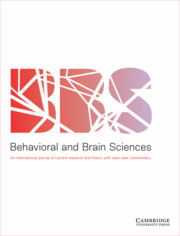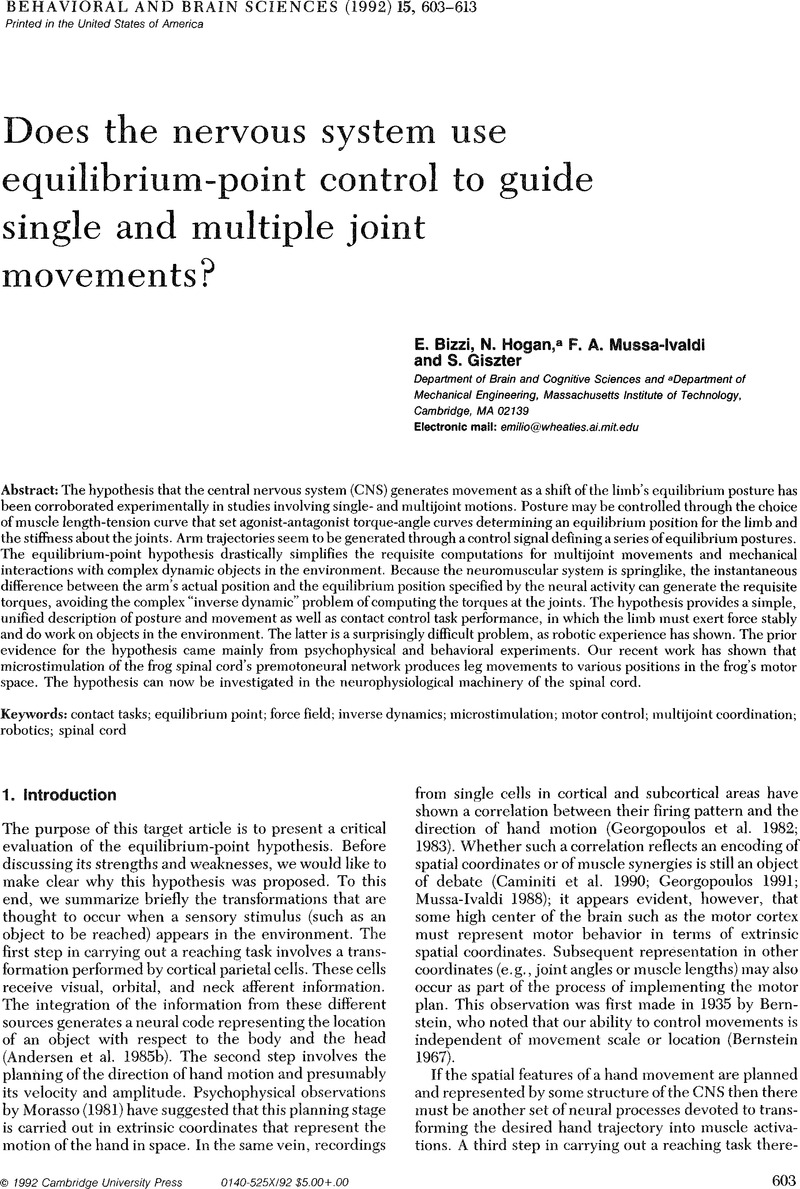Crossref Citations
This article has been cited by the following publications. This list is generated based on data provided by Crossref.
St-Onge, Nancy
Qi, Haiming
and
Feldman, Anatol G.
1993.
The patterns of control signals underlying elbow joint movements in humans.
Neuroscience Letters,
Vol. 164,
Issue. 1-2,
p.
171.
Latash, Mark L.
and
Zatsiorsky, Vladimir M.
1993.
Joint stiffness: Myth or reality?.
Human Movement Science,
Vol. 12,
Issue. 6,
p.
653.
lngvaldsen, R.
and
Whiting, H.T.A.
1995.
Frameworks on shifting sands.
Behavioral and Brain Sciences,
Vol. 18,
Issue. 4,
p.
764.
Scott, Stephen H.
1995.
Can the λ model be used to interpret the activity of single neurons?.
Behavioral and Brain Sciences,
Vol. 18,
Issue. 4,
p.
778.
Corcos, Daniel M.
and
Pfann, Kerstin
1995.
Conservative or nonconservative control schemes.
Behavioral and Brain Sciences,
Vol. 18,
Issue. 4,
p.
747.
Dean, Jeffrey
1995.
The lambda model is only one piece in the motor control puzzle.
Behavioral and Brain Sciences,
Vol. 18,
Issue. 4,
p.
749.
Fikes, Thomas G.
and
Townsend, James T.
1995.
Moving models of motion forward: Explication and a new concept.
Behavioral and Brain Sciences,
Vol. 18,
Issue. 4,
p.
751.
Hodgson, Antony
1995.
The unobservability of central commands: Why testing hypotheses is so difficult.
Behavioral and Brain Sciences,
Vol. 18,
Issue. 4,
p.
763.
Flanagan, J. Randall
Tresilian, James R.
and
Wing, Alan M.
1995.
Grip force adjustments during rapid hand movements suggest that detailed movement kinematics are predicted.
Behavioral and Brain Sciences,
Vol. 18,
Issue. 4,
p.
753.
Ostry, David J.
Laboissière, Rafael
and
Gribble, Paul L.
1995.
Command invariants and the frame of reference for human movement.
Behavioral and Brain Sciences,
Vol. 18,
Issue. 4,
p.
770.
Nichols, T. Richard
1995.
Interneurons as backseat drivers and the elusive control variable.
Behavioral and Brain Sciences,
Vol. 18,
Issue. 4,
p.
772.
Loeb, Gerald E.
1995.
What can we expect from models of motor control?.
Behavioral and Brain Sciences,
Vol. 18,
Issue. 4,
p.
767.
Pagano, Christopher C.
and
Bingham, Geoffrey P.
1995.
Spatial frames for motor control would be commensurate with spatial frames for vision and proprioception, but what about control of energy flows?.
Behavioral and Brain Sciences,
Vol. 18,
Issue. 4,
p.
773.
Kay, Bruce A.
1995.
Frames of reference interact and are task-dependent.
Behavioral and Brain Sciences,
Vol. 18,
Issue. 4,
p.
765.
Patla, Aftab E.
1995.
The λ model: Can it walk?.
Behavioral and Brain Sciences,
Vol. 18,
Issue. 4,
p.
775.
Partridge, Lloyd D.
1995.
Let us accept a “controlled trade-off” model of motor control.
Behavioral and Brain Sciences,
Vol. 18,
Issue. 4,
p.
773.
McDonald, P. Vernon
1995.
Can the λ model benefit from understanding human adaptation in weightlessness(and vice versa)?.
Behavioral and Brain Sciences,
Vol. 18,
Issue. 4,
p.
768.
Levin, Mindy F.
and
Feldman, Anatol G.
1995.
The λ model for motor control: More than meets the eye.
Behavioral and Brain Sciences,
Vol. 18,
Issue. 4,
p.
786.
Thelen, Esther
1995.
Origins of origins of motor control.
Behavioral and Brain Sciences,
Vol. 18,
Issue. 4,
p.
780.
Haggard, Patrick
Miall, Chris
and
Stein, John
1995.
Twisted pairs: Does the motor system really care about joint configurations?.
Behavioral and Brain Sciences,
Vol. 18,
Issue. 4,
p.
758.



